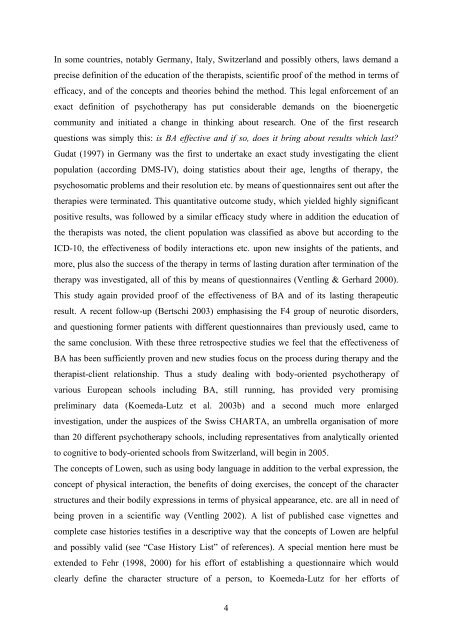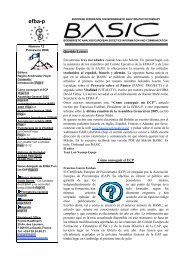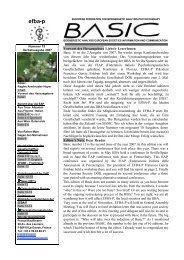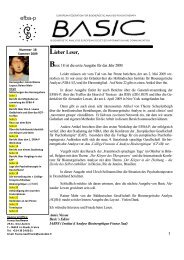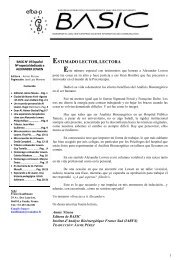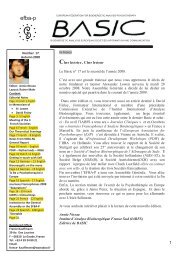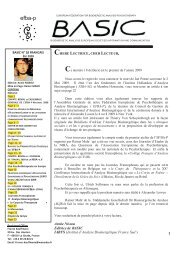December 2004 - European Federation for Bioenergetic Analysis ...
December 2004 - European Federation for Bioenergetic Analysis ...
December 2004 - European Federation for Bioenergetic Analysis ...
Create successful ePaper yourself
Turn your PDF publications into a flip-book with our unique Google optimized e-Paper software.
In some countries, notably Germany, Italy, Switzerland and possibly others, laws demand a<br />
precise definition of the education of the therapists, scientific proof of the method in terms of<br />
efficacy, and of the concepts and theories behind the method. This legal en<strong>for</strong>cement of an<br />
exact definition of psychotherapy has put considerable demands on the bioenergetic<br />
community and initiated a change in thinking about research. One of the first research<br />
questions was simply this: is BA effective and if so, does it bring about results which last?<br />
Gudat (1997) in Germany was the first to undertake an exact study investigating the client<br />
population (according DMS-IV), doing statistics about their age, lengths of therapy, the<br />
psychosomatic problems and their resolution etc. by means of questionnaires sent out after the<br />
therapies were terminated. This quantitative outcome study, which yielded highly significant<br />
positive results, was followed by a similar efficacy study where in addition the education of<br />
the therapists was noted, the client population was classified as above but according to the<br />
ICD-10, the effectiveness of bodily interactions etc. upon new insights of the patients, and<br />
more, plus also the success of the therapy in terms of lasting duration after termination of the<br />
therapy was investigated, all of this by means of questionnaires (Ventling & Gerhard 2000).<br />
This study again provided proof of the effectiveness of BA and of its lasting therapeutic<br />
result. A recent follow-up (Bertschi 2003) emphasising the F4 group of neurotic disorders,<br />
and questioning <strong>for</strong>mer patients with different questionnaires than previously used, came to<br />
the same conclusion. With these three retrospective studies we feel that the effectiveness of<br />
BA has been sufficiently proven and new studies focus on the process during therapy and the<br />
therapist-client relationship. Thus a study dealing with body-oriented psychotherapy of<br />
various <strong>European</strong> schools including BA, still running, has provided very promising<br />
preliminary data (Koemeda-Lutz et al. 2003b) and a second much more enlarged<br />
investigation, under the auspices of the Swiss CHARTA, an umbrella organisation of more<br />
than 20 different psychotherapy schools, including representatives from analytically oriented<br />
to cognitive to body-oriented schools from Switzerland, will begin in 2005.<br />
The concepts of Lowen, such as using body language in addition to the verbal expression, the<br />
concept of physical interaction, the benefits of doing exercises, the concept of the character<br />
structures and their bodily expressions in terms of physical appearance, etc. are all in need of<br />
being proven in a scientific way (Ventling 2002). A list of published case vignettes and<br />
complete case histories testifies in a descriptive way that the concepts of Lowen are helpful<br />
and possibly valid (see “Case History List” of references). A special mention here must be<br />
extended to Fehr (1998, 2000) <strong>for</strong> his ef<strong>for</strong>t of establishing a questionnaire which would<br />
clearly define the character structure of a person, to Koemeda-Lutz <strong>for</strong> her ef<strong>for</strong>ts of<br />
4


